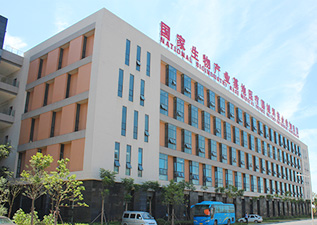客戶文獻分享| 整合組學(xué)和轉(zhuǎn)基因分析揭示了紫外線B照射通過上調(diào)SmNAC1對丹酚酸生物合成產(chǎn)生積極作用
本期解讀
題目:Integrative omic and transgenic analyses revealthe positive effect of ultraviolet-B irradiation on salvianolic acidbiosynthesis through upregulation of SmNAC1
期刊:The Plant Journal
影響因子:6.141/Q1
合作技術(shù):iTRAQ定量蛋白組學(xué)
一、研究背景
丹酚酸SalAs是丹參中重要的水溶性成分,有助于治療腦血管和心血管疾病。據(jù)報道,在12種增加的丹酚酸中,丹酚酸B、丹酚酸A、迷迭香酸和丹參素對治療腦血管疾病具有活性。最近,越來越多的研究旨在提高丹參中SalA的含量。并且已有研究表明,通過適當劑量的UV-B照射可以在體內(nèi)增加SalA含量;然而,這種現(xiàn)象背后的機制仍然未知。
二、技術(shù)路線圖
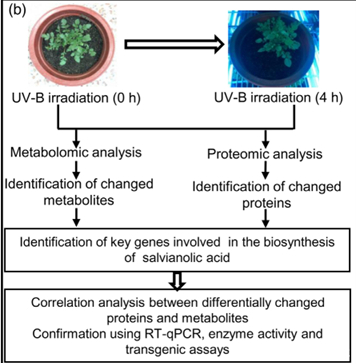
三、實驗結(jié)果
1. UV-B照射誘導(dǎo)丹參SalA合成的適宜時間選擇
為了選擇合適的 UV-B 照射條件,分析對比了在中度時長(4 小時)和長時間(16 小時)的UV-B照射后丹參的表型和丹酚酸的含量。結(jié)果顯示,丹參在UV-B照射4小時后正常生長,但照射16小時后幾乎死亡(圖1(a)。與對照組相比,UV-B 照射4小時后丹酚酸水平顯著增加,處理16小時后僅略有增加(圖1(a)。因此,選擇暴露于UV-B照射0小時(對照)和4小時(UV-B處理)的丹參用于響應(yīng)UV-B照射的進一步生理、生化和分子研究(圖 1(b))。

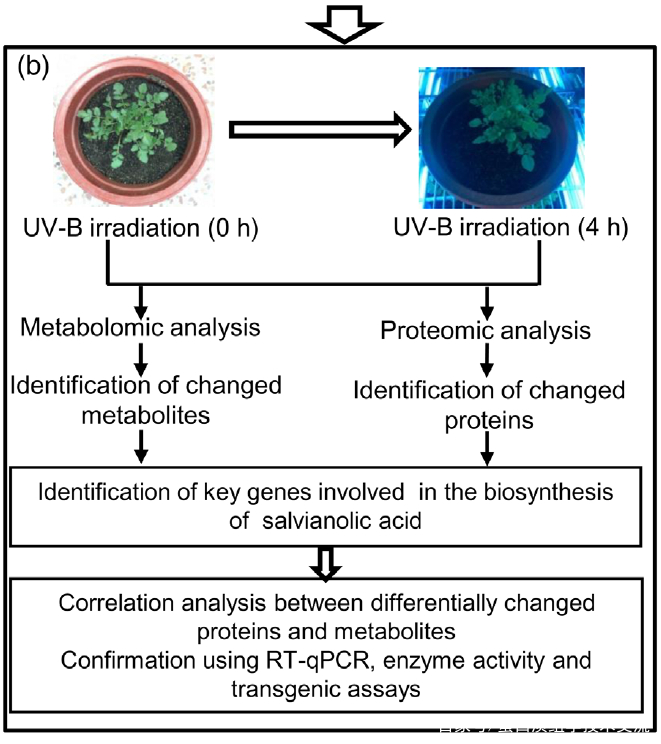
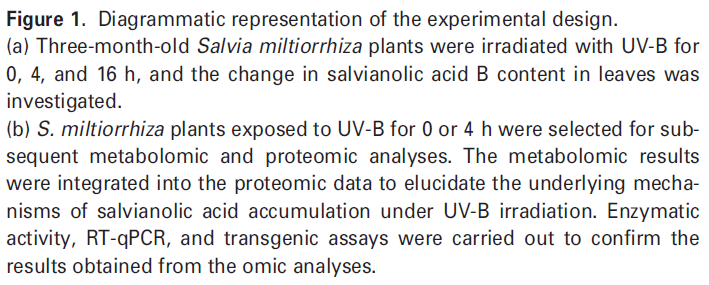
2. UV-B輻射下丹參中SalAs含量變化的代謝組學(xué)檢測
研究者利用比較代謝組學(xué)方法系統(tǒng)地分析了0小時(對照)和4小時UV-B照射的丹參葉和根中SalAs的含量(圖1(b))。代謝組學(xué)結(jié)果表明,經(jīng)UV-B照射的葉子或根部獲得的總離子色譜圖與未照射樣品的總離子色譜圖明顯不同(圖 S1(a,b))。從丹參的葉和根中分別鑒定出1255和1853個離子(圖2(a)),并且通過主成分分析(PCA)將UV-B照射的樣品與對照樣品清楚地聚集在一起(圖S2(a,b))。使用Fold-Change ≥1.5(顯著增加;P≤0.05)或≤0.5(顯著減少;P≤0.05)的篩選標準,245和325個離子(共570個)分別在葉片中增加和減少,90和91個離子(共181個)分別在根中增加和減少(圖2(a))。值得注意的是,已被證實在SalA生物合成中發(fā)揮重要作用的茉莉酸(JA)和SA的含量在丹參葉片中也確實顯著增加(圖S5和6;表S3)。
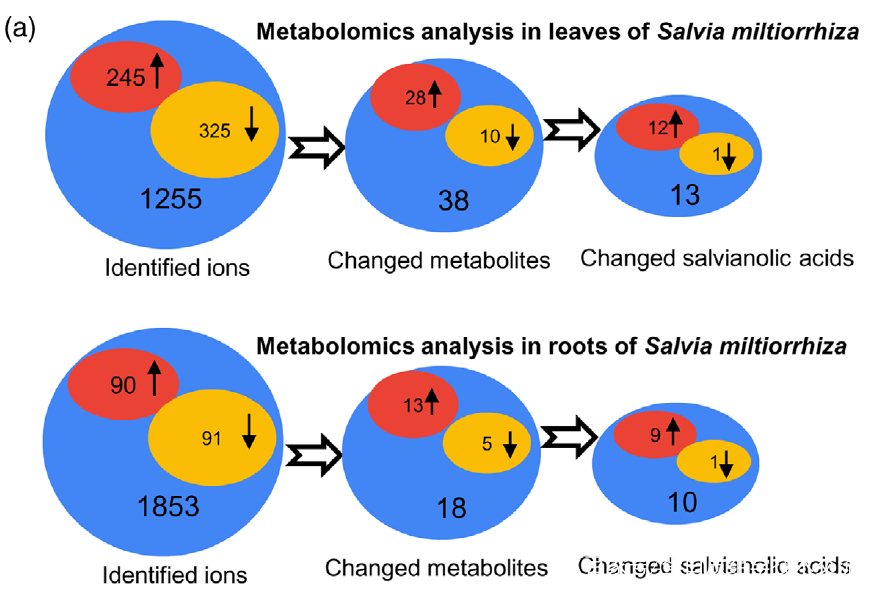
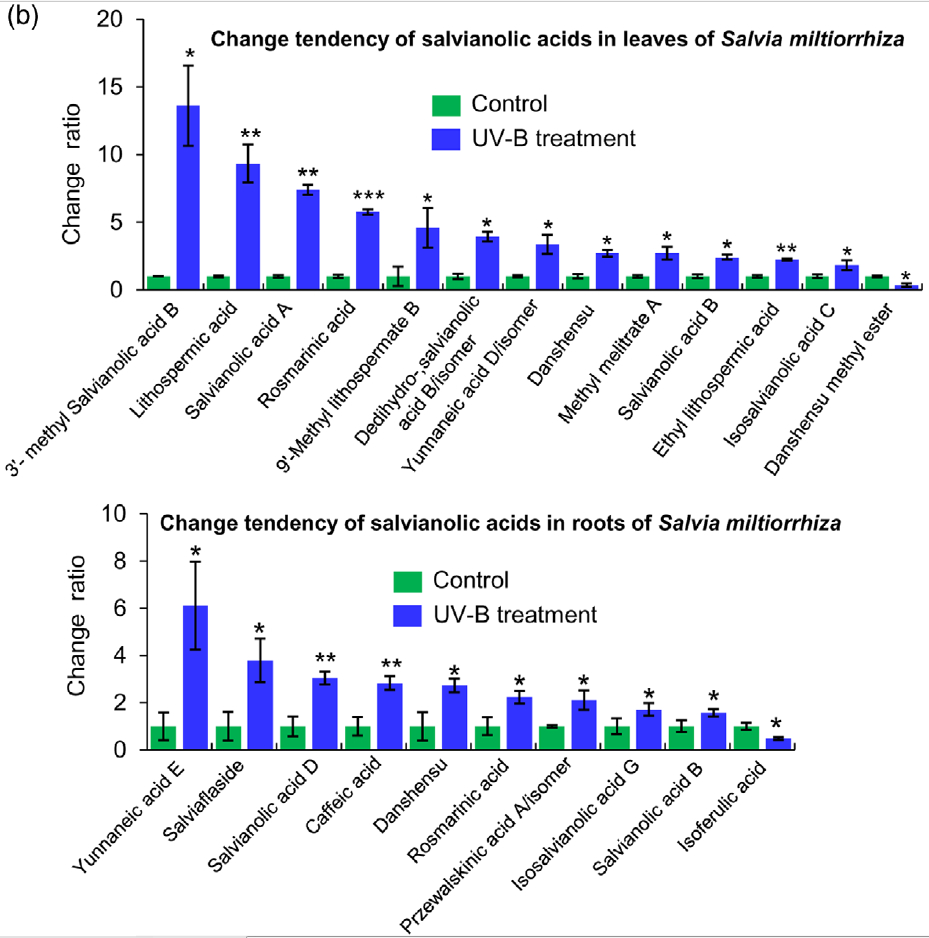
Figure 2. Effects of UV-B exposure on salvianolic acid (SalA) contents in leaves and roots of Salvia miltiorrhiza. Three-month-old S. miltiorrhiza plants were either untreated (controls) or treated with UVB exposure for 4 h. Metabolites extracted from leaves or roots were subjected to metabolomic analysis using untargeted ultra-performance liquid chromatography-quadrupole-time of flight mass spectrometry (UPLC-Q/TOF-MS).
(a) The statistical numbers of identified ions, metabolites, and SalAs from leaves and roots are listed. The arrows facing upward and downward
indicate increases and decreases, respectively, upon UV-B treatment.
(b) Relative abundances of 13 and 10 significantly changed SalAs in leaves and roots, respectively, as calculated based on the obtained peak areas, and the resulting values in UV-B-exposed samples versus control were compared. Data represent means SDs of three independent biological replicates. Significant differences between UV-B-irradiated and control samples were determined using the Student t-test (*P < 0.05, **P < 0.01, ***P <0.001).
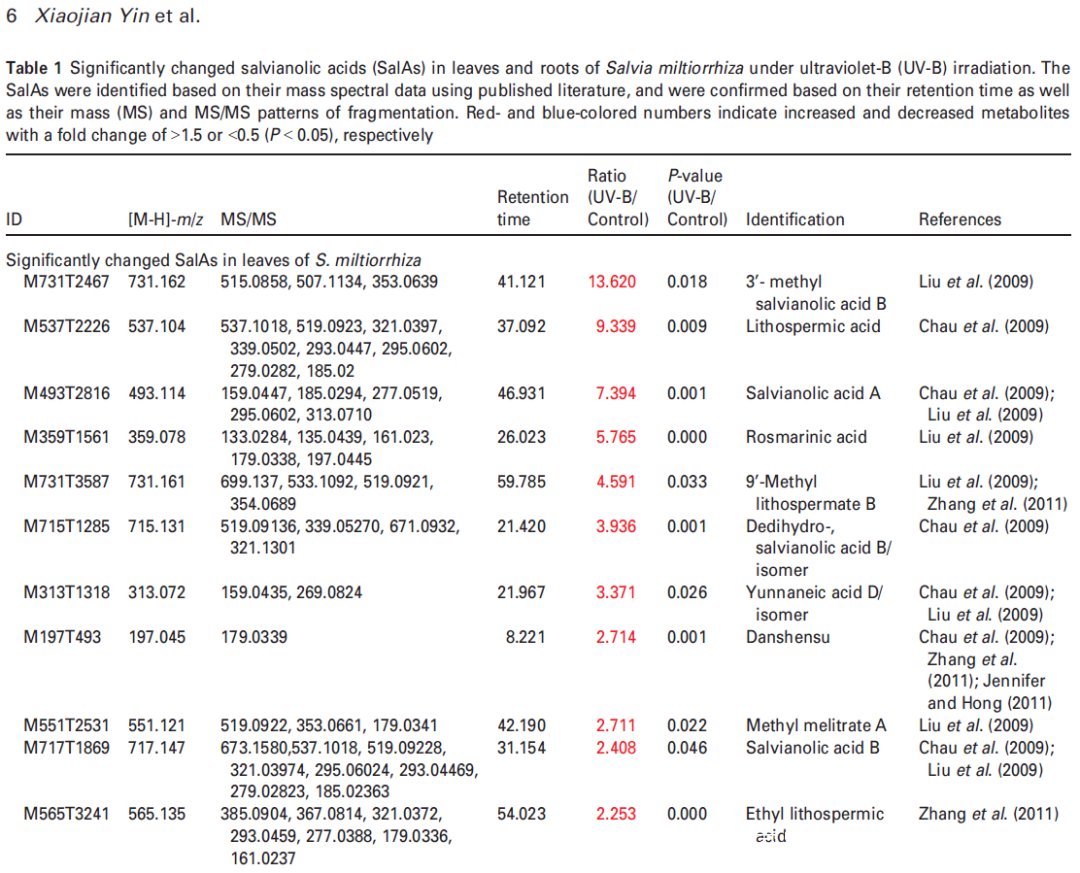
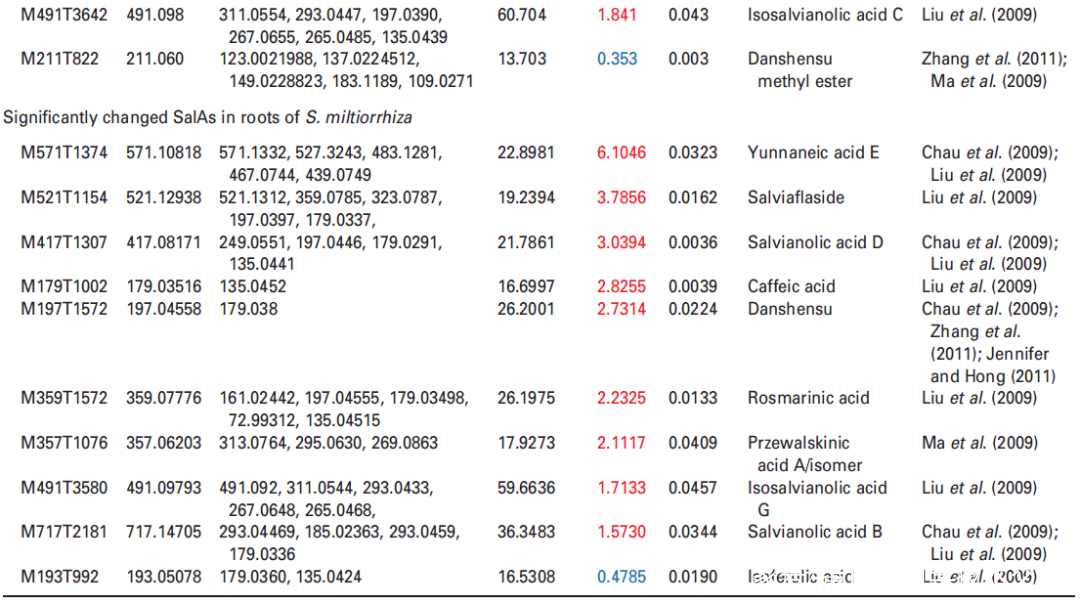
3. 蛋白質(zhì)組學(xué)分析揭示了UV-B照射下與SalA生物合成直接相關(guān)的關(guān)鍵酶的變化
研究者進一步使用比較蛋白質(zhì)組學(xué)分析探索了經(jīng)UV-B照射誘導(dǎo)的SalA 生物合成機制。基于金開瑞公司的iTRAQ蛋白質(zhì)組學(xué)方法對UV-B處理組和對照組樣品的葉和根進行質(zhì)譜檢測分析。分析所有獲得的肽段長度和unique肽的數(shù)量,以評估蛋白質(zhì)組數(shù)據(jù)的質(zhì)量,結(jié)果表明,鑒定出的肽段由8-38個氨基酸和2-20個unique肽段組成,使用置信度95%的過濾數(shù)據(jù),在葉和根組織中總共鑒定出16830和21120個肽段,分別比對鑒定到的3303和3620個蛋白(圖3(a))。根據(jù)Fold-Change大于1.4或小于0.7(P < 0.05)的篩選標準,鑒定到在UV-B照射下,丹參葉片中281個蛋白表達量顯著上調(diào),155個蛋白表達量顯著下調(diào)。(圖3(a);表S4),在丹參根中分別有102和157個蛋白表達量顯著上調(diào)和下調(diào)(圖3(a);表S5)。為支持蛋白質(zhì)組學(xué)結(jié)果,經(jīng)酶活性檢測,在UV-B照射的丹參植物葉片中,經(jīng)代謝組學(xué)檢測分析得到的與SalA生物合成相關(guān)的關(guān)鍵酶苯丙氨酸氨裂合酶(PAL)、酪氨酸轉(zhuǎn)氨酶 (TAT)等的活性也被確定顯著增強(圖3(c))。
進一步分析蛋白質(zhì)組學(xué)數(shù)據(jù),在UV-B處理的丹參葉子中,顯示9種轉(zhuǎn)錄因子TF的蛋白表達水平升高,包括與擬南芥直系同源的bHLH1、bHLH2、bHLH3、NAC1、WRKY12、WRKY44、WRKY48、WRKY56和WRKY61,此外,發(fā)現(xiàn)與JA生物合成相關(guān)脂氧合酶(LOX) 和SA生物合成相關(guān)PAL蛋白表達水平顯著升高在UV-B與對照相比(表2),與JA和SA的代謝積累一致(圖S5和6;表S3)。在丹參根中,僅檢測到兩種TF的水平,即bHLH2和NAC1,在UV-B照射下顯著增加,而UV-B照射后丹參根中JA生物合成相關(guān)酶的水平?jīng)]有顯著變化(表2)。
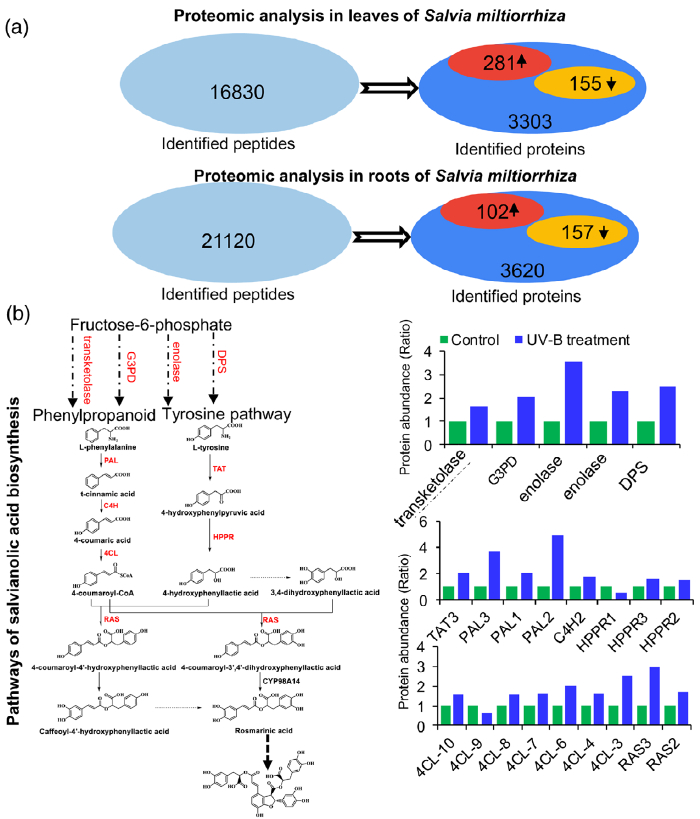
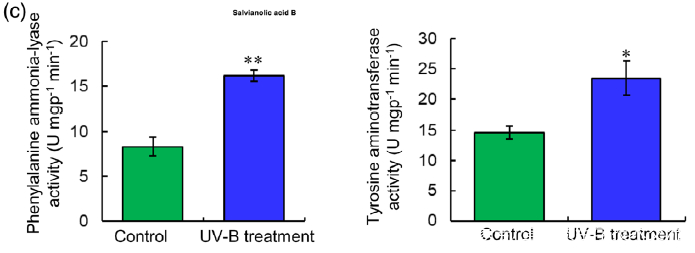
Figure 3. Proteomic analysis to identify key proteins involved in the biosynthesis of salvianolic acids (SalAs) under UV-B irradiation.
(a) Three-month-old Salvia miltiorrhiza plants were irradiated with UV-B for 4 h and compared with controls. The extracted proteins from leaves or
roots were subjected to a proteomic analysis. Differentially expressed proteins (DEPs) were identified by comparing protein levels in UV-B-irradiated versus control samples. Statistical analysis of identified peptides, proteins, and DEPs from leaves and roots, respectively, was performed. The arrows facing upward and downward indicate increases and decreases, respectively, due to UV-B exposure.
(b) (Left) Biosynthetic pathways of SalA from fructose-6-phosphate. SalA biosynthesis-related enzymes include transketolase, glyceraldehyde 3-
phosphate dehydrogenase (G3PD), enolase, 3- deoxy-7-phosphoheptulonate synthase (DPS), phenylalanine ammonia-lyase (PAL), tyrosine aminotransferase (TAT), cinnamate 4-hydroxylase (C4H), 4-coumarate:coenzyme A ligase (4CL), hydroxyphenylpyruvate reductase (HPPR), and rosmarinic acid synthase (RAS). Red color indicates proteins with increased abundance after UV-B irradiation. (Right) Protein abundance in control and treated samples.
(c) PAL and TAT enzymatic activities in control and UV-B-irradiated samples were measured. Data are presented as means SDs of three independent biological replicates. Significant differences between UV-B-irradiated and control samples were determined using the Student t-test (*P < 0.05, **P< 0.01).

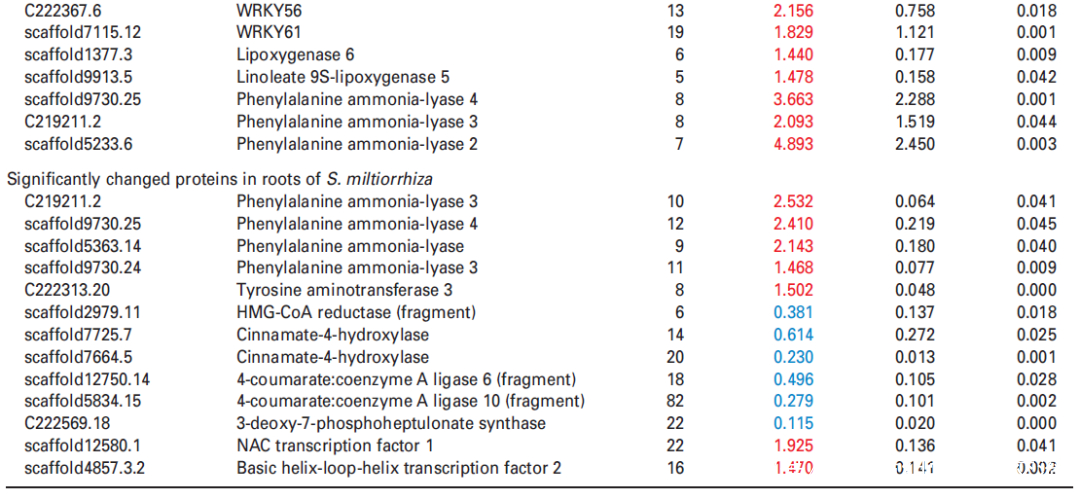
4. 蛋白組與代謝組關(guān)聯(lián)分析
在本研究中,通過代謝組學(xué)分析發(fā)現(xiàn),在UV-B照射下丹參葉片中有12種SalAs含量升高(圖2(b);另一方面,蛋白質(zhì)組學(xué)結(jié)果顯示,與SalA生物合成、轉(zhuǎn)錄調(diào)控、蛋白質(zhì)穩(wěn)態(tài)(proteostasis)、光合作用、葉綠素合成和蔗糖代謝相關(guān)的蛋白質(zhì)受UV-B照射影響較為顯著(表2和S6)。進行蛋白組與代謝組關(guān)聯(lián)分析,系統(tǒng)地評估了SalAs含量和UV-B應(yīng)激蛋白水平變化之間的關(guān)系。如圖4所示,根據(jù)與SalA含量的相關(guān)值,將顯著變化的蛋白分為三個聚類。丹酚酸和迷迭香酸水平與定位在II簇的蛋白如SalA生物合成相關(guān)蛋白和TFs呈正相關(guān);然而,它們與定位于簇I的蛋白呈負相關(guān),包括光合作用相關(guān)蛋白(圖4;表S7)。
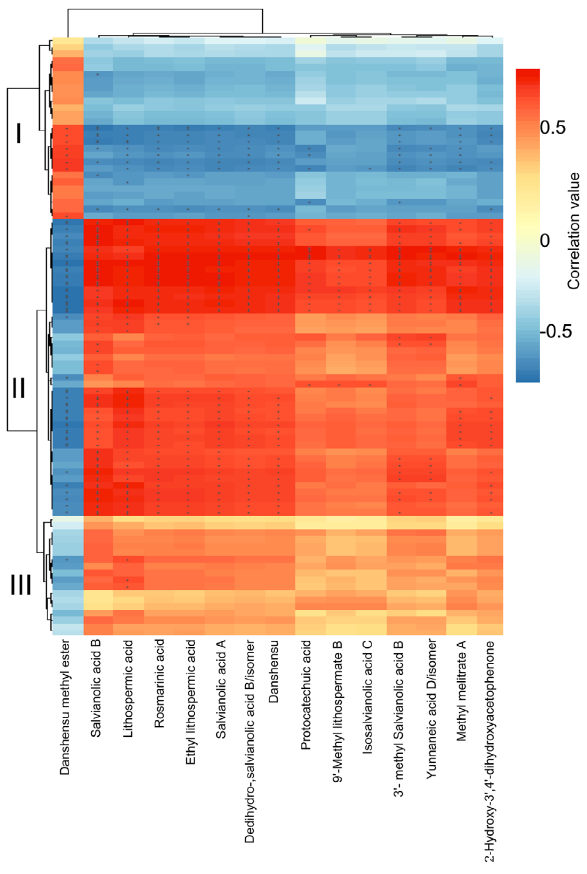
Figure 4. Correlation analysis between differentially expressed proteins and significantly changed salvianolic acids (SalAs). The use of the Pearson correlation coefficient enabled the establishment of the correlation between proteins that were significantly different in abundance and significantly changed SalAs. An asterisk indicates a significant correlation between differentially expressed proteins and differentially accumulated SalAs. Red and blue colors indicate positive and negative correlations, respectively. Detailed coefficient values are listed in Table S7.
5. NAC1在SalAs生物合成中的作用
研究者注意到在UV-B照射樣本中,轉(zhuǎn)錄因子NAC1(或 SmNAC1)在丹參葉組織中表達量上調(diào)最為顯著(圖5(b),表明NAC1可能在SalA生物合成中起著關(guān)鍵調(diào)節(jié)作用。為了證明這一假設(shè),使用含有帶Flag標記的NAC1過表達質(zhì)粒或帶有綠色熒光蛋白(GFP)的NAC1-RNAi質(zhì)粒的農(nóng)桿菌Agrobacterium rhizogenes C58C1來合成過表達或沉默NAC1基因的轉(zhuǎn)基因毛根NAC1-OE和NAC1-SI(圖S8(a,b))。為了鑒定NAC1調(diào)控的基因,使用 NAC1-OE、NAC1-SI和對照組的毛根進行比較轉(zhuǎn)錄組分析。結(jié)果表明,SalA生物合成相關(guān)基因在NAC1-SI毛根中下調(diào)(表S8);PAL2的表達在NAC1-OE毛根中高度上調(diào),而在NAC1-SI毛根中沒有顯著變化(表S8)。接下來,通過RT-qPCR評估了轉(zhuǎn)基因毛狀根中幾種SalA生物合成相關(guān)基因的表達水平。正如預(yù)期的那樣,與SalA生物合成相關(guān)的大部分基因和酶分別在NAC1-OE和NAC1-SI毛根中被顯著誘導(dǎo)和抑制(圖6(b))。聚類分析進一步證實了SalA生物合成相關(guān)基因的表達水平的變化和編碼蛋白水平的變化顯示出相似的趨勢(圖S9)。
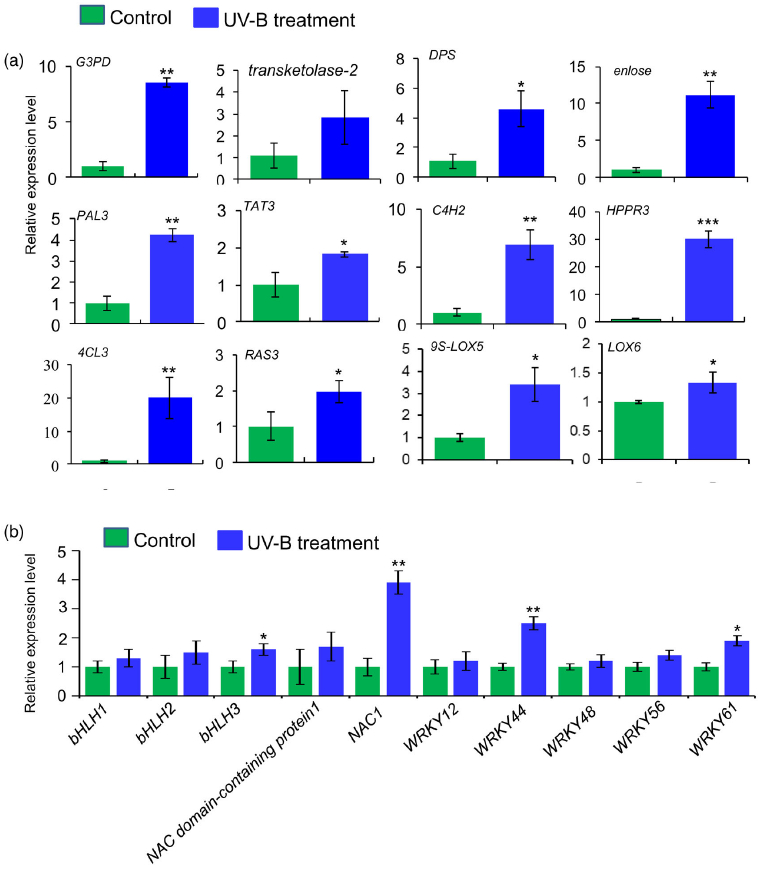

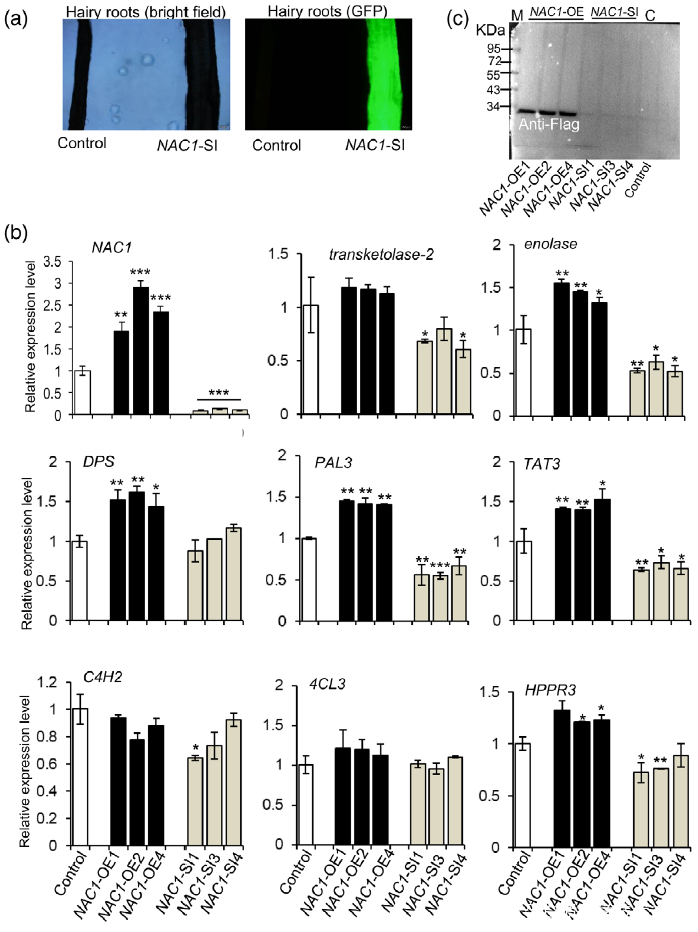
Figure 6. Overexpression or silencing of the NAC1 gene affects the expression of salvianolic acid (SalA) biosynthesis-related genes in hairy roots of Salvia miltiorrhiza.
(a) Green fluorescence protein (GFP) expression was observed by fluorescence microscopy to verify the presence of the NAC1-RNAi plasmid.
(b) Expression of genes related to SalA biosynthesis in NAC1-overexpressing (NAC1-OE) and NAC1-silencing (NAC1-SI) hairy roots. Data shown are means SDs of three independent biological replicates.
Significant differences between UV-B-irradiated and control samples were determined using the Student t-test (*P < 0.05, **P < 0.01, ***P <0.001).
(c) Increased NAC1 protein levels in NAC1-OE hairy roots as indicated by western blot analysis using anti-Flag. M, protein marker; C, control.
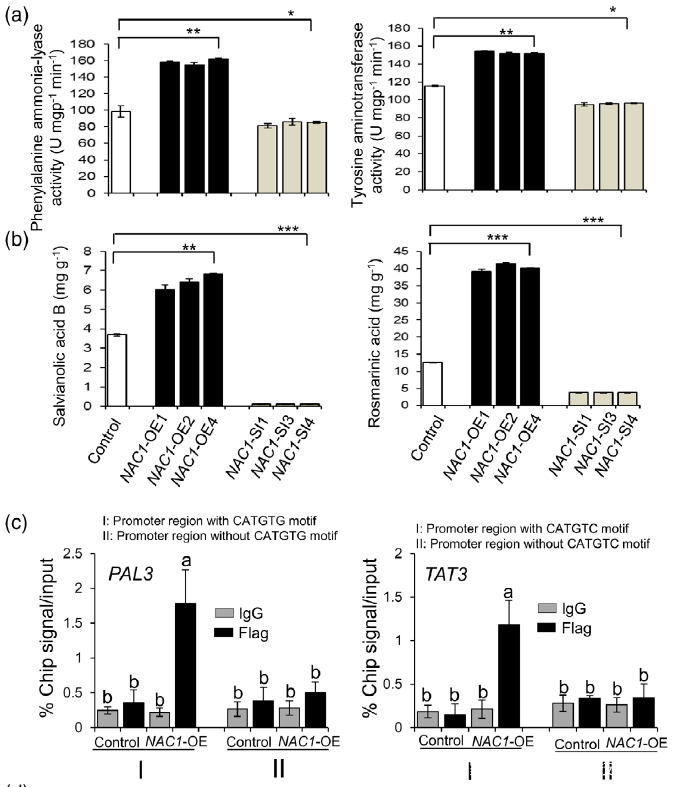
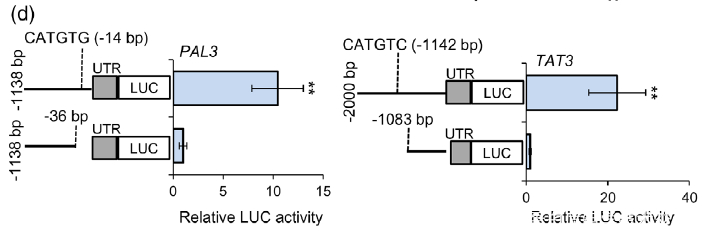
Figure 7. Effects of overexpression or silencing of NAC1 on the salvianolic acid B and rosmarinic acid contents.
(a) PAL and TAT enzymatic activities in NAC1-overexpressing (NAC1-OE) and NAC1-silencing (NAC1- SI) hairy roots.
(b) Rosmarinic acid and salvianolic acid B contents in NAC1-OE and NAC1-SI hairy roots. Data are expressed as means SDs of three independent biological replicates. Significant differences between UV-B-irradiated and control samples were determined using the Student t-test (*P < 0.05, **P< 0.01, ***P < 0.001).
(c) ChIP-qPCR assay using hairy roots of NAC1-OE and control lines. Immunoprecipitation (IP) was performed using an anti-Flag antibody or normal mouse immunoglobulin G (IgG) (negative control). PAL3 promoter regions with or without CATGTG cis-motif and TAT3 promoter regions with or without CATGTC cis-motif were comparatively amplified by RT-qPCR. The error bars indicate the SDs from three independent experiments. Different letters indicate statistical significance as analyzed using one-way ANOVA with Tukey’s multiple comparison (P < 0.05). TAT3, tyrosine aminotransferase 3; PAL3, phenylalanine ammonia-lyase 3.
(d) Dual-LUC assay showed the effect of NAC1 on the activation of PAL3 and TAT3 promoters. The promoters of PAL3 (with CATGTG) and TAT3 (with CATGTC) were individually fused to the luciferase (LUC) reporter gene. As negative control, the promoters of PAL3 and TAT3 genes without cis-motif were fused to the LUC gene. The promoter activities were determined by transient expression in tobacco. Relative LUC activity was normalized to the Renilla (REN) luciferase. Error bars indicate SD (n = 3). Significant differences were determined by the Student t-test (**P < 0.01).
四、總結(jié)
在這項研究中,研究者對暴露于4小時UV-B照射的丹參葉子和根進行了綜合的代謝組學(xué)和蛋白質(zhì)組學(xué)分析,代謝組學(xué)分析結(jié)果顯示,經(jīng)UV-B處理的丹參的葉和根中分別增加了12和9種SalAs。通過蛋白質(zhì)組學(xué)分析獲得的數(shù)據(jù)表明,暴露于UV-B輻射的丹參幼苗根中上調(diào)的SalA生物合成相關(guān)關(guān)鍵酶的數(shù)量(5種酶)遠低于葉片中的(20種酶)(表2),并找到了SalA合成的關(guān)鍵轉(zhuǎn)錄調(diào)控因子NAC1。最后通過進一步的蛋白質(zhì)組學(xué)分析、基因過表達和沉默、轉(zhuǎn)基因?qū)嶒灥冗M一步驗證了關(guān)鍵蛋白和基因的功能,并在分子水平上討論UV-B誘導(dǎo)丹參SalA生物合成的機制。
最新動態(tài)
-
09.23
中藥的現(xiàn)代詮釋:外泌體如何革新傳統(tǒng)醫(yī)學(xué)?
-
07.02
1+1>2!深度解析RNA測序數(shù)據(jù)挖掘邏輯和后期實驗設(shè)計思路,輕松研獲10+ SCI
-
07.01
“稻”亦有道——盤點近期水稻研究的重大突破
-
06.28
科學(xué)與美學(xué)的結(jié)合體:植物亞細胞定位技術(shù)詳解
-
06.28
“聚焦新質(zhì)生產(chǎn)力,激發(fā)科研新動能”|LCA躋身蛋白互作研究的新銳力量
-
06.05
知無不“研”|一文讀懂免疫共沉淀技術(shù)(Co-IP)
-
05.14
四大研究利器(Co-IP、BIFC、Y2H、GST pull-down)助力速配蛋白互作“最佳拍檔”
-
05.14
高效、精準、直觀、實時——取經(jīng)“蛋白互作研究翹楚”BIFC!
-
05.14
轉(zhuǎn)染效率低、干擾效果差、重復(fù)性欠佳...siRNA研究頻遇“攔路虎”怎么辦?
-
04.22
一文讀懂EMSA技術(shù)核心要點,讓“emsa” 秒變“easy”

